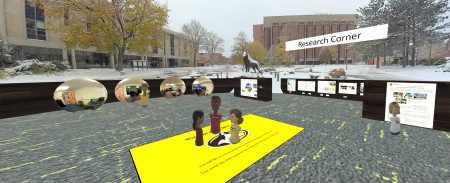
Curiosity and the excitement of new discoveries led Dr. Ricardo Eiris to combine engineering and computer science in his work. An assistant professor in the Civil, Environmental, and Geospatial Engineering (CEGE) department at Michigan Tech, he was drawn to the changing landscape of civil and construction engineering, as caused by the rapid development of new technologies and their innovative applications.
Eiris wants to advance, through the use of new technologies, an understanding of the underlying processes and mechanisms that support the attraction, retention, and lifelong learning of engineering professionals. His research also seeks to understand how humans interact with technology in complex civil and construction situations.
“We spend over one-third of our life immersed into our careers, constantly learning and evolving during our time in the workforce,” Eiris says. “Engineering as a career is complex and multidimensional, and engineering professionals have a profound impact on nature and society.”
“Particularly, I’m very excited about exploring how we can use technologies to foster diversity and inclusion in STEM,” he says. “New advances in virtual reality are making engineering more accessible than ever, to anyone and anywhere!”
Technologies Eiris researches include virtual reality, omnidirectional photography, virtual humans, and unmanned aerial vehicles (UAV/drones). He is currently working on the project, “VR-Huskies – Virtual Site Visits for Authentic STEM Experiences,” which is funded by a College of Engineering COVID-19 Seed Grant. VR-Huskies is a custom implementation of Mozilla Hubs®, an open-source platform that creates custom dynamic representations of information.

The VR-Huskies technology, previewed at the 2020 and 2021 HCC Research Expos, allows up to 25 participants to easily enter a virtual site and interact with up to 25 others. VR Huskies is accessible on any device, including head-mounted displays, desktop computers, laptops, tablets, and mobile devices. For the HCC Expo, participants explored the latest research developments in human-centered computing at Michigan Tech.
In his teaching, Eiris fosters critical thinking, problem-solving, communication, and collaboration, and he concentrates on helping students gain the knowledge and skills to become lifelong learners. His teaching interests include building information modeling; construction technologies like VR, AR, and drones; and building utility systems. This academic year he teaches Introduction to Building Information Modeling (BIM) and Building Utility Systems
Eiris is working with Ph.D. student Josiane Isingizwe (CEGE), who is researching the use of Virtual Reality in civil engineering and construction educational applications.
Away from work and research, Eiris greatly enjoys tinkering with computers and electronics. “A basic understanding of the sciences is incredibly helpful to successfully play around with computers to automate tasks, create things like games, and explore the world through cameras, data collection devices, and other technology,” he notes. “New technologies are advancing very quickly, so I always have new gadgets in my lab to tinker around with and apply in my research.”
Eiris is also a gamer and a musician. He loves playing drums, videogames and board games, and exploring the outdoors. The strong research emphasis at Michigan Tech, the supportive academic community, and the beautiful Keweenaw peninsula are what drew Eiris to the Houghton area, and the same things keep him here.
Eiris has a Ph.D. in Design, Construction, and Planning; M.S. degrees in Construction Management, Civil Engineering, and Digital Arts & Sciences; and a B.S. in Civil Engineering. He is an affiliate member of the American Society of Civil Engineers (ASCE). He has published dozens of peer-reviewed journal articles, conference papers, and posters.